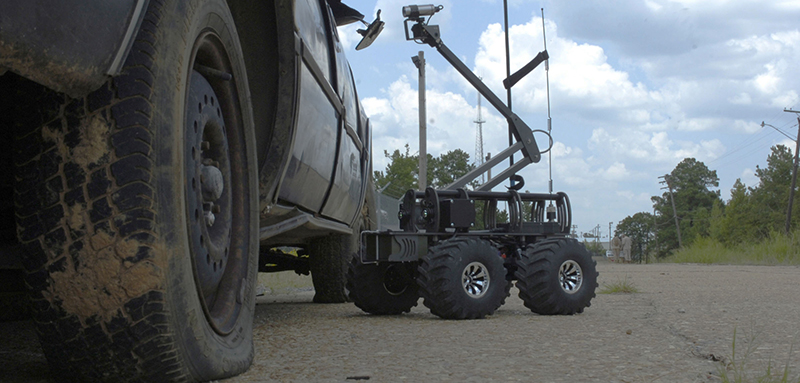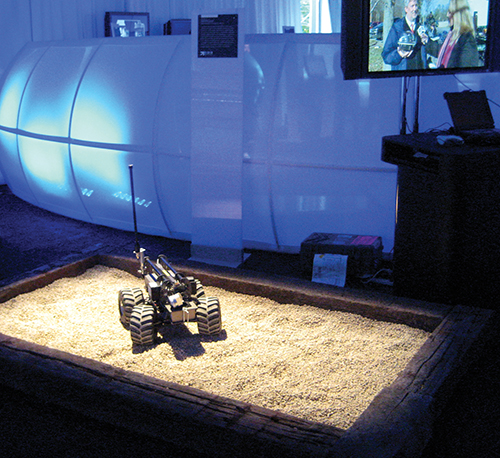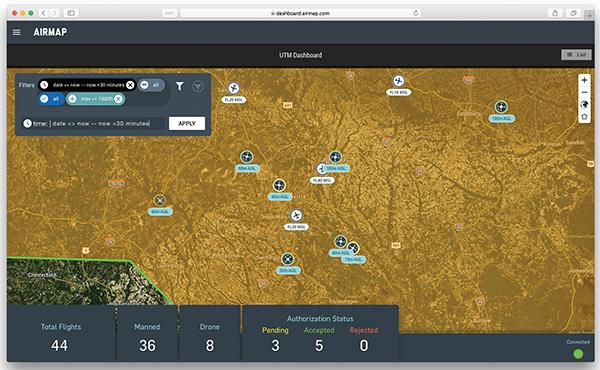
Robots Save Soldiers’ Lives Overseas
Originating Technology/NASA Contribution
NASA intends to return people to the Moon, but this time to stay. Future plans include living quarters, scientific laboratories, a permanent lunar community, and a training ground for a future mission to Mars. Ahead of these first 21st century boots on the Moon, though, the Space Agency needs to make sure a couple of things are in place, including one thing that most of us here on Earth have begun to accept as a necessary part of any human existence: the Internet.
NASA is designing a mobile communications platform so that a planned series of scouting robots can communicate with one another, astronauts on the Moon, and mission controllers on Earth. These robot scouts will initially serve as beacons to help triangulate coordinates, including potential landing sites. They will also carry simple science experiments for studying the new locale, taking dust measurements, profiles of local geochemistry, and astronomical readings.
Once in place, though, NASA wants these scouts to begin acting as relay points for a wireless communications network—essentially putting the Internet on the Moon. This network, while essential for NASA’s own purposes, will also eliminate many compatibility issues for communicating with international partners who join us on the lunar surface. With each nation designing its own space hardware, universal wireless communications reduce the difficulties of connecting communications equipment.
Working toward this goal, engineers at Marshall Space Flight Center, as part of the Science Mission Directorate’s Self-Aware Surface Network project, are designing a prototype of a communications network which will enable sensor-webs, data sharing, communications, and navigation on the Moon’s surface.
As an unexpected early benefit of this NASA research, the U.S. Army received a souped-up reconnaissance tool that is now being deployed to keep soldiers safer in war zones.
Partnership
Huntsville, Alabama-based Marshall engineers provided their counterparts at the Army’s nearby Redstone Arsenal with unexpected design upgrades for one of its remotely operated reconnaissance robots. The Multi-function Agile Remote Control Robot (MARCbot) is a device that the Army has been deploying to Iraq since 2004 to help soldiers search out and identify improvised explosive devices (IEDs). It was developed for the Army by an engineering consulting firm, Exponent Inc., headquartered in Menlo Park, California, with 19 offices across the country and representing over 90 scientific and technical disciplines.
NASA became involved with the project, not just because of the proximity to Redstone or because both the Space Agency and the Army are actively engaged in studying how best to integrate and coordinate humans and robots to do some of the hardest jobs in the universe. Rather, NASA saw the low-cost MARCbots being tested and bought two from its neighbor to test its mobile communications platform.
While tinkering with the devices, the Marshall engineers made a few design changes, making the robot simpler and faster while adding myriad capabilities. They essentially gutted the device and replaced all of its electronics, upgrading from an analog camera to a digital setup, encrypting the controllers and video transmission, as well as significantly increasing the range and adding communications abilities. Despite all of these upgrades, they also managed to simplify the design, providing more plug-and-play sensors and replacing some of the complex electronics with more trouble-free, low-cost components.
When they demonstrated the modified robot to its former owners, the Army was impressed and wanted these design changes reproduced in future models. The Huntsville-based Von Braun Center for Science and Innovation, a local NASA-affiliated nonprofit, helped coordinate this partnership, which involved the transfer of intellectual property between two large government agencies and the contracting of two private companies to carry out the work on a third company’s existing product. Schafer Corporation, also in Huntsville, had designed the control system for the updated robot, and Applied Geo Technologies Inc. (AGT), a tribally-owned corporation in Choctaw, Mississippi, was given the task of manufacturing the modified Exponent MARCbots.
AGT is currently producing 40 new systems per month, upgrading the original Exponent product to make the MARCbot IV-N, the “N” designating its NASA roots. It has completed over 300 of these units, all of which are on their way overseas for active duty. They are also producing a kit so that already-deployed units can be upgraded in the field.
Product Outcome
According to the U.S. Department of Defense, IEDs have been responsible for approximately half of all U.S. and coalition force casualties and combat injuries in Iraq.
These devices disrupt supply convoys, destroy assets, and have been credited with killing or maiming thousands of soldiers. The MARCbot is a remotely operated reconnaissance robot specifically developed to identify IEDs and maintaining a safe distance—allowing a soldier to assess whether an object is a potential IED while avoiding close (and perhaps dangerous) physical proximity. It is used to hunt down threats to soldiers by allowing a suspected IED to be examined remotely.
The small-wheeled robot is easy to use. It operates with a standard laptop using Windows software and is operated with a common video game controller. In fact, when looking for components, the NASA engineers actually stopped by a series of local pawn shops and purchased used video game controllers, knowing that these parts were readily-accessible, cheap, and most importantly, would be used intuitively by the average young soldier. Although it operates much like a remote-controlled toy car, this robot has features not found under the Christmas tree: It is several times more rugged than even the most robust toy and comes equipped with a video camera, GPS, compass, and an articulated arm. Once it travels so far, it also has way-finding features, so the operator can instruct the robot to find its own way back, following a memorized path.
Reports have come back from the battlefield of soldiers giving their MARCbots names, honorary medals and ranks, and mourning their loss in combat.
Currently, one user operates a single MARCbot IV-N, but future plans are to have one operator oversee a fleet of semi-autonomous robots in order to gain complete situational awareness. Future plans also include adding radiation sensors and plume detection for dirty bomb cleanup and mitigation.
Windows® is a registered trademark of Microsoft Corporation.

The Multi-function Agile Remote Control Robot (MARCbot) pictured here on display at WIRED NextFest, an annual showcase of innovative technologies transforming the world, is a tele-operated reconnaissance robot developed to identify explosives from a safe distance.

The MARCbot received multiple upgrades from engineers at NASA’s Marshall Space Flight Center, and hundreds have now been deployed by the U.S. military overseas to help soldiers identify improvised explosive devices.













